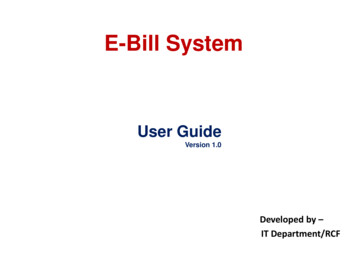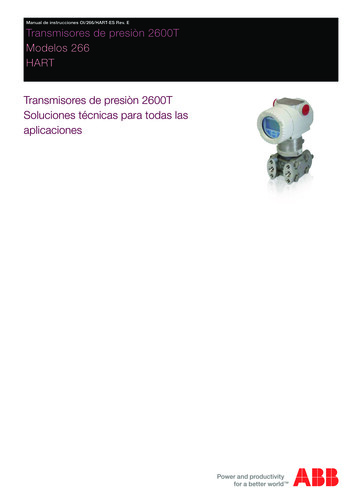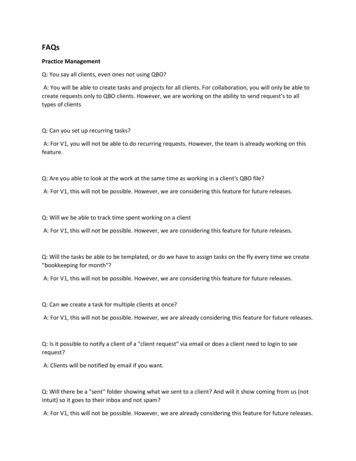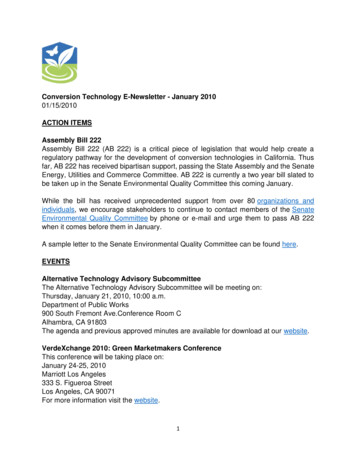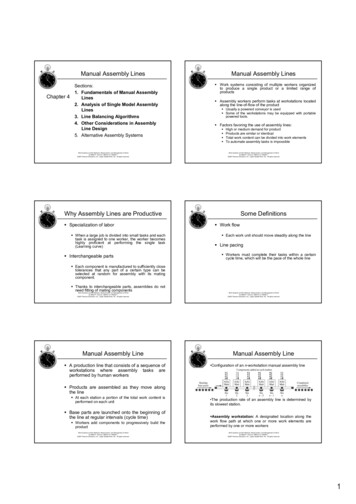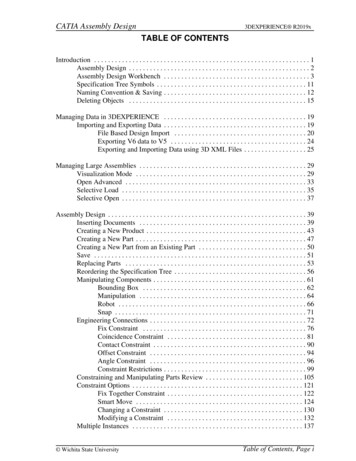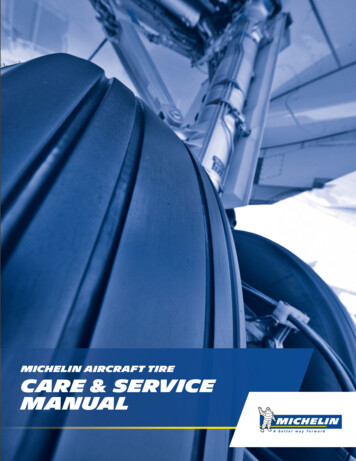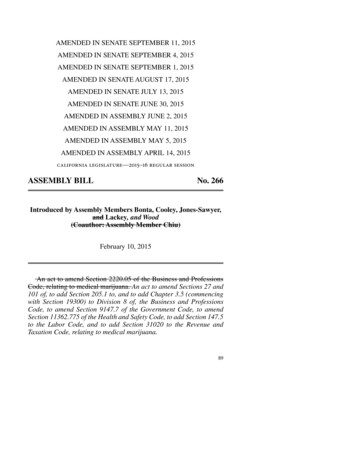
Transcription
AMENDED IN SENATE SEPTEMBER 11, 2015AMENDED IN SENATE SEPTEMBER 4, 2015AMENDED IN SENATE SEPTEMBER 1, 2015AMENDED IN SENATE AUGUST 17, 2015AMENDED IN SENATE JULY 13, 2015AMENDED IN SENATE JUNE 30, 2015AMENDED IN ASSEMBLY JUNE 2, 2015AMENDED IN ASSEMBLY MAY 11, 2015AMENDED IN ASSEMBLY MAY 5, 2015AMENDED IN ASSEMBLY APRIL 14, 2015california legislature—2015–16 regular sessionASSEMBLY BILLNo. 266Introduced by Assembly Members Bonta, Cooley, Jones-Sawyer,and Lackey, and Wood(Coauthor: Assembly Member Chiu)February 10, 2015An act to amend Section 2220.05 of the Business and ProfessionsCode, relating to medical marijuana. An act to amend Sections 27 and101 of, to add Section 205.1 to, and to add Chapter 3.5 (commencingwith Section 19300) to Division 8 of, the Business and ProfessionsCode, to amend Section 9147.7 of the Government Code, to amendSection 11362.775 of the Health and Safety Code, to add Section 147.5to the Labor Code, and to add Section 31020 to the Revenue andTaxation Code, relating to medical marijuana.89
AB 266—2—legislative counsel’s digestAB 266, as amended, Bonta. Medical Board of California: cannabis.Medical marijuana.(1) Existing law, the Compassionate Use Act of 1996, an initiativemeasure enacted by the approval of Proposition 215 at the November5, 1996, statewide general election, authorizes the use of marijuana formedical purposes. Existing law enacted by the Legislature requires theestablishment of a program for the issuance of identification cards toqualified patients so that they may lawfully use marijuana for medicalpurposes, and requires the establishment of guidelines for the lawfulcultivation of marijuana grown for medical use. Existing law providesfor the licensure of various professions by boards or bureaus withinthe Department of Consumer Affairs. Existing law, the Sherman Food,Drug, and Cosmetic Law, provides for the regulation of food, drugs,devices, and cosmetics, as specified. A violation of that law is a crime.This bill, among other things, would enact the Medical MarijuanaRegulation and Safety Act for the licensure and regulation of medicalmarijuana and would establish within the Department of ConsumerAffairs the Bureau of Medical Marijuana Regulation, under thesupervision and control of the Director of Consumer Affairs. The billwould require the director to administer and enforce the provisions ofthe act.This bill would also require the Board of Equalization, in consultationwith the Department of Food and Agriculture, to adopt a system forreporting the movement of commercial cannabis and cannabis products.This bill would impose certain fines and civil penalties for specifiedviolations of the act, and would require moneys collected as a result ofthese fines and civil penalties to be deposited into the Medical CannabisFines and Penalties Account.(2) Under existing law, certain persons with identification cards,who associate within the state in order collectively or cooperatively tocultivate marijuana for medical purposes, are not solely on the basisof that fact subject to specified state criminal sanctions.This bill would repeal these provisions upon the issuance of licensesby licensing authorities pursuant to the Medical Marijuana Regulationand Safety Act, as specified, and would instead provide that actions oflicensees with the relevant local permits, in accordance with the actand applicable local ordinances, are not offenses subject to arrest,prosecution, or other sanction under state law.89
—3—AB 266(3) This bill would provide that its provisions are severable.(4) Existing constitutional provisions require that a statute that limitsthe right of access to the meetings of public bodies or the writings ofpublic officials and agencies be adopted with findings demonstratingthe interest protected by the limitation and the need for protecting thatinterest.This bill would make legislative findings to that effect.(5) The California Constitution requires the state to reimburse localagencies and school districts for certain costs mandated by the state.Statutory provisions establish procedures for making thatreimbursement.This bill would provide that, if the Commission on State Mandatesdetermines that the bill contains costs mandated by the state,reimbursement for those costs shall be made pursuant to these statutoryprovisions.(6) The bill would provide that it shall become operative only if SB643 and AB 243 of the 2015–16 Regular Session are also enacted andbecome operative.Existing law, the Compassionate Use Act of 1996, an initiativemeasure enacted by the approval of Proposition 215 at the November6, 1996, statewide general election, authorizes the use of marijuana formedical purposes. Existing law requires the Medical Board of Californiato prioritize its investigative and prosecutorial resources to ensure thatthe most harmful physicians and surgeons are identified and disciplinedexpeditiously, and provides a list of allegations that shall be prioritized.This bill would add repeatedly recommending excessive cannabisto patients for medical purposes, and repeatedly recommending cannabisto patients without a good faith examination and a medical reason, tothe list of prioritized allegations.This bill would become operative only if SB 643 of the 2015–16Regular Session is enacted and becomes operative.Vote: majority. Appropriation: no. Fiscal committee: yes.State-mandated local program: no yes.The people of the State of California do enact as follows:linelinelineline1234SECTION 1. Section 27 of the Business and Professions Codeis amended to read:27. (a) Each entity specified in subdivisions (c), (d), and (e)shall provide on the Internet information regarding the status of89
AB 266line 1line 2line 3line 4line 5line 6line 7line 8line 9line 10line 11line 12line 13line 14line 15line 16line 17line 18line 19line 20line 21line 22line 23line 24line 25line 26line 27line 28line 29line 30line 31line 32line 33line 34line 35line 36line 37line 38line 39line 40—4—every license issued by that entity in accordance with the CaliforniaPublic Records Act (Chapter 3.5 (commencing with Section 6250)of Division 7 of Title 1 of the Government Code) and theInformation Practices Act of 1977 (Chapter 1 (commencing withSection 1798) of Title 1.8 of Part 4 of Division 3 of the Civil Code).The public information to be provided on the Internet shall includeinformation on suspensions and revocations of licenses issued bythe entity and other related enforcement action, includingaccusations filed pursuant to the Administrative Procedure Act(Chapter 3.5 (commencing with Section 11340) of Part 1 ofDivision 3 of Title 2 of the Government Code) taken by the entityrelative to persons, businesses, or facilities subject to licensure orregulation by the entity. The information may not include personalinformation, including home telephone number, date of birth, orsocial security number. Each entity shall disclose a licensee’saddress of record. However, each entity shall allow a licensee toprovide a post office box number or other alternate address, insteadof his or her home address, as the address of record. This sectionshall not preclude an entity from also requiring a licensee, whohas provided a post office box number or other alternative mailingaddress as his or her address of record, to provide a physicalbusiness address or residence address only for the entity’s internaladministrative use and not for disclosure as the licensee’s addressof record or disclosure on the Internet.(b) In providing information on the Internet, each entity specifiedin subdivisions (c) and (d) shall comply with the Department ofConsumer Affairs’ guidelines for access to public records.(c) Each of the following entities within the Department ofConsumer Affairs shall comply with the requirements of thissection:(1) The Board for Professional Engineers, Land Surveyors, andGeologists shall disclose information on its registrants andlicensees.(2) The Bureau of Automotive Repair shall disclose informationon its licensees, including auto repair dealers, smog stations, lampand brake stations, smog check technicians, and smog inspectioncertification stations.(3) The Bureau of Electronic and Appliance Repair, HomeFurnishings, and Thermal Insulation shall disclose information onits licensees and registrants, including major appliance repair89
—5—line 1line 2line 3line 4line 5line 6line 7line 8line 9line 10line 11line 12line 13line 14line 15line 16line 17line 18line 19line 20line 21line 22line 23line 24line 25line 26line 27line 28line 29line 30line 31line 32line 33line 34line 35line 36line 37line 38line 39AB 266dealers, combination dealers (electronic and appliance), electronicrepair dealers, service contract sellers, and service contractadministrators.(4) The Cemetery and Funeral Bureau shall disclose informationon its licensees, including cemetery brokers, cemetery salespersons,cemetery managers, crematory managers, cemetery authorities,crematories, cremated remains disposers, embalmers, funeralestablishments, and funeral directors.(5) The Professional Fiduciaries Bureau shall discloseinformation on its licensees.(6) The Contractors’ State License Board shall discloseinformation on its licensees and registrants in accordance withChapter 9 (commencing with Section 7000) of Division 3. Inaddition to information related to licenses as specified insubdivision (a), the board shall also disclose information providedto the board by the Labor Commissioner pursuant to Section 98.9of the Labor Code.(7) The Bureau for Private Postsecondary Education shalldisclose information on private postsecondary institutions underits jurisdiction, including disclosure of notices to comply issuedpursuant to Section 94935 of the Education Code.(8) The California Board of Accountancy shall discloseinformation on its licensees and registrants.(9) The California Architects Board shall disclose informationon its licensees, including architects and landscape architects.(10) The State Athletic Commission shall disclose informationon its licensees and registrants.(11) The State Board of Barbering and Cosmetology shalldisclose information on its licensees.(12) The State Board of Guide Dogs for the Blind shall discloseinformation on its licensees and registrants.(13) The Acupuncture Board shall disclose information on itslicensees.(14) The Board of Behavioral Sciences shall discloseinformation on its licensees, including licensed marriage and familytherapists, licensed clinical social workers, licensed educationalpsychologists, and licensed professional clinical counselors.(15) The Dental Board of California shall disclose informationon its licensees.89
AB 266line 1line 2line 3line 4line 5line 6line 7line 8line 9line 10line 11line 12line 13line 14line 15line 16line 17line 18line 19line 20line 21line 22line 23line 24line 25line 26line 27line 28line 29line 30line 31line 32line 33line 34line 35line 36line 37line 38line 39line 40—6—(16) The State Board of Optometry shall disclose informationregarding certificates of registration to practice optometry,statements of licensure, optometric corporation registrations, branchoffice licenses, and fictitious name permits of its licensees.(17) The Board of Psychology shall disclose information on itslicensees, including psychologists, psychological assistants, andregistered psychologists.(d) The State Board of Chiropractic Examiners shall discloseinformation on its licensees.(e) The Structural Pest Control Board shall disclose informationon its licensees, including applicators, field representatives, andoperators in the areas of fumigation, general pest and wooddestroying pests and organisms, and wood roof cleaning andtreatment.(f) The Bureau of Medical Marijuana Regulation shall discloseinformation on its licensees.(f)(g) “Internet” for the purposes of this section has the meaningset forth in paragraph (6) of subdivision (f) of Section 17538.SEC. 2. Section 101 of the Business and Professions Code isamended to read:101. The department is comprised of the following:(a) The Dental Board of California.(b) The Medical Board of California.(c) The State Board of Optometry.(d) The California State Board of Pharmacy.(e) The Veterinary Medical Board.(f) The California Board of Accountancy.(g) The California Architects Board.(h) The Bureau of Barbering and Cosmetology.(i) The Board for Professional Engineers and Land Surveyors.(j) The Contractors’ State License Board.(k) The Bureau for Private Postsecondary Education.(l) The Bureau of Electronic and Appliance Repair, HomeFurnishings, and Thermal Insulation.(m) The Board of Registered Nursing.(n) The Board of Behavioral Sciences.(o) The State Athletic Commission.(p) The Cemetery and Funeral Bureau.(q) The State Board of Guide Dogs for the Blind.89
—7—line 1line 2line 3line 4line 5line 6line 7line 8line 9line 10line 11line 12line 13line 14line 15line 16line 17line 18line 19line 20line 21line 22line 23line 24line 25line 26line 27line 28line 29line 30line 31line 32line 33line 34line 35line 36AB 266(r) The Bureau of Security and Investigative Services.(s) The Court Reporters Board of California.(t) The Board of Vocational Nursing and PsychiatricTechnicians.(u) The Landscape Architects Technical Committee.(v) The Division of Investigation.(w) The Bureau of Automotive Repair.(x) The Respiratory Care Board of California.(y) The Acupuncture Board.(z) The Board of Psychology.(aa) The California Board of Podiatric Medicine.(ab) The Physical Therapy Board of California.(ac) The Arbitration Review Program.(ad) The Physician Assistant Committee.(ae) The Speech-Language Pathology and Audiology Board.(af) The California Board of Occupational Therapy.(ag) The Osteopathic Medical Board of California.(ah) The Naturopathic Medicine Committee.(ai) The Dental Hygiene Committee of California.(aj) The Professional Fiduciaries Bureau.(ak) The State Board of Chiropractic Examiners.(al) The Bureau of Real Estate.(am) The Bureau of Real Estate Appraisers.(an) The Structural Pest Control Board.(ao) The Bureau of Medical Marijuana Regulation.(ao)(ap) Any other boards, offices, or officers subject to itsjurisdiction by law.SEC. 3. Section 205.1 is added to the Business and ProfessionsCode, to read:205.1. Notwithstanding subdivision (a) of Section 205, theMedical Marijuana Regulation and Safety Act Fund is a specialfund within the Professions and Vocations Fund, and is subject tosubdivision (b) of Section 205.SEC. 4. Chapter 3.5 (commencing with Section 19300) is addedto Division 8 of the Business and Professions Code, to read:89
AB 266line 1line 2line 3line 4line 5line 6line 7line 8line 9line 10line 11line 12line13line 14line 15line 16line 17line 18line 19line 20line 21line 22line 23line 24line 25line 26line 27line 28line 29line 30line 31line 32line 33line 34line 35line 36line 37line 38line 39line 40—8—Chapter 3.5. Medical Marijuana Regulation and SafetyactArticle 1. Definitions19300. This act shall be known and may be cited as the MedicalMarijuana Regulation and Safety Act.19300.5. For purposes of this chapter, the following definitionsshall apply:(a) “Accrediting body” means a nonprofit organization thatrequires conformance to ISO/IEC 17025 requirements and is asignatory to the International Laboratory AccreditationCooperation Mutual Recognition Arrangement for Testing.(b) “Applicant,” for purposes of Article 4 (commencing withSection 19319), means the following:(1) Owner or owners of a proposed facility, including all personsor entities having ownership interest other than a security interest,lien, or encumbrance on property that will be used by the facility.(2) If the owner is an entity, “owner” includes within the entityeach person participating in the direction, control, or managementof, or having a financial interest in, the proposed facility.(3) If the applicant is a publicly traded company, “owner”means the chief executive officer or any person or entity with anaggregate ownership interest of 5 percent or more.(c) “Batch” means a specific quantity of medical cannabis ormedical cannabis products that is intended to have uniformcharacter and quality, within specified limits, and is producedaccording to a single manufacturing order during the same cycleof manufacture.(d) “Bureau” means the Bureau of Medical MarijuanaRegulation within the Department of Consumer Affairs.(e) “Cannabinoid” or “phytocannabinoid” means a chemicalcompound that is unique to and derived from cannabis.(f) “Cannabis” means all parts of the plant Cannabis sativaLinnaeus., Cannabis indica, or Cannabis ruderalis, whethergrowing or not; the seeds thereof; the resin, whether crude orpurified, extracted from any part of the plant; and every compound,manufacture, salt, derivative, mixture, or preparation of the plant,its seeds, or resin. “Cannabis” also means the separated resin,89
—9—line 1line 2line 3line 4line 5line 6line 7line 8line 9line 10line 11line 12line 13line 14line 15line 16line 17line 18line 19line 20line 21line 22line 23line 24line 25line 26line 27line 28line 29line 30line 31line 32line 33line 34line 35line 36line 37line 38line 39line 40AB 266whether crude or purified, obtained from marijuana. “Cannabis”also means marijuana as defined by Section 11018 of the Healthand Safety Code as enacted by Chapter 1407 of the Statutes of1972. “Cannabis” does not include the mature stalks of the plant,fiber produced from the stalks, oil or cake made from the seeds ofthe plant, any other compound, manufacture, salt, derivative,mixture, or preparation of the mature stalks (except the resinextracted therefrom), fiber, oil, or cake, or the sterilized seed ofthe plant which is incapable of germination. For the purpose ofthis chapter, “cannabis” does not mean “industrial hemp” asdefined by Section 81000 of the Food and Agricultural Code orSection 11018.5 of the Health and Safety Code.(g) “Cannabis concentrate” means manufactured cannabis thathas undergone a process to concentrate the cannabinoid activeingredient, thereby increasing the product’s potency. An ediblemedical cannabis product is not considered food, as defined bySection 109935 of the Health and Safety Code, or a drug, asdefined by Section 109925 of the Health and Safety Code.(h) “Caregiver” or “primary caregiver” has the same meaningas that term is defined in Section 11362.7 of the Health and SafetyCode.(i) “Certificate of accreditation” means a certificate issued byan accrediting body to a licensed testing laboratory, entity, or siteto be registered in the state.(j) “Chief” means Chief of the Bureau of Medical MarijuanaRegulation within the Department of Consumer Affairs.(k) “Commercial cannabis activity” includes cultivation,possession, manufacture, processing, storing, laboratory testing,labeling, transporting, distribution, or sale of medical cannabisor a medical cannabis product, except as set forth in Section 19319,related to qualifying patients and primary caregivers.(l) “Cultivation” means any activity involving the planting,growing, harvesting, drying, curing, grading, or trimming ofcannabis.(m) “Delivery” means the commercial transfer of medicalcannabis or medical cannabis products from a dispensary, up toan amount determined by the bureau to a primary caregiver orqualified patient as defined in Section 11362.7 of the Health andSafety Code, or a testing laboratory. “Delivery” also includes theuse by a dispensary of any technology platform owned and89
AB 266line 1line 2line 3line 4line 5line 6line 7line 8line 9line 10line 11line 12line 13line 14line 15line 16line 17line 18line 19line 20line 21line 22line 23line 24line 25line 26line 27line 28line 29line 30line 31line 32line 33line 34line 35line 36line 37line 38line 39line 40— 10 —controlled by the dispensary, or independently licensed under thischapter, that enables qualified patients or primary caregivers toarrange for or facilitate the commercial transfer by a licenseddispensary of medical cannabis or medical cannabis products.(n) “Dispensary” means a facility where medical cannabis,medical cannabis products, or devices for the use of medicalcannabis or medical cannabis products are offered, eitherindividually or in any combination, for retail sale, including anestablishment that delivers, pursuant to express authorization bylocal ordinance, medical cannabis and medical cannabis productsas part of a retail sale.(o) “Dispensing” means any activity involving the retail saleof medical cannabis or medical cannabis products from adispensary.(p) “Distribution” means the procurement, sale, and transportof medical cannabis and medical cannabis products betweenentities licensed pursuant to this chapter.(q) “Distributor” means a person licensed under this chapterto engage in the business of purchasing medical cannabis from alicensed cultivator, or medical cannabis products from a licensedmanufacturer, for sale to a licensed dispensary.(r) “Dried flower” means all dead medical cannabis that hasbeen harvested, dried, cured, or otherwise processed, excludingleaves and stems.(s) “Edible cannabis product” means manufactured cannabisthat is intended to be used, in whole or in part, for humanconsumption, including, but not limited to, chewing gum. An ediblemedical cannabis product is not considered food as defined bySection 109935 of the Health and Safety Code or a drug as definedby Section 109925 of the Health and Safety Code.(t) “Fund” means the Medical Marijuana Regulation and SafetyAct Fund established pursuant to Section 19351.(u) “Identification program” means the universal identificationcertificate program for commercial medical cannabis activityauthorized by this chapter.(v) “Labor peace agreement” means an agreement between alicensee and a bona fide labor organization that, at a minimum,protects the state’s proprietary interests by prohibiting labororganizations and members from engaging in picketing, workstoppages, boycotts, and any other economic interference with the89
— 11 —line 1line 2line 3line 4line 5line 6line 7line 8line 9line 10line 11line 12line 13line 14line 15line 16line 17line 18line 19line 20line 21line 22line 23line 24line 25line 26line 27line 28line 29line 30line 31line 32line 33line 34line 35line 36line 37line 38line 39AB 266applicant’s business. This agreement means that the applicant hasagreed not to disrupt efforts by the bona fide labor organizationto communicate with, and attempt to organize and represent, theapplicant’s employees. The agreement shall provide a bona fidelabor organization access at reasonable times to areas in whichthe applicant’s employees work, for the purpose of meeting withemployees to discuss their right to representation, employmentrights under state law, and terms and conditions of employment.This type of agreement shall not mandate a particular method ofelection or certification of the bona fide labor organization.(w) “Licensing authority” means the state agency responsiblefor the issuance, renewal, or reinstatement of the license, or thestate agency authorized to take disciplinary action against thelicense.(x) “Cultivation site” means a facility where medical cannabisis planted, grown, harvested, dried, cured, graded, or trimmed, orthat does all or any combination of those activities, that holds avalid state license pursuant to this chapter, and that holds a validlocal license or permit.(y) “Manufacturer” means a person that conducts theproduction, preparation, propagation, or compounding ofmanufactured medical cannabis, as described in subdivision (ae),or medical cannabis products either directly or indirectly or byextraction methods, or independently by means of chemicalsynthesis or by a combination of extraction and chemical synthesisat a fixed location that packages or repackages medical cannabisor medical cannabis products or labels or relabels its container,that holds a valid state license pursuant to this chapter, and thatholds a valid local license or permit.(z) “Testing laboratory” means a facility, entity, or site in thestate that offers or performs tests of medical cannabis or medicalcannabis products and that is both of the following:(1) Accredited by an accrediting body that is independent fromall other persons involved in the medical cannabis industry in thestate.(2) Registered with the State Department of Public Health.(aa) “Transporter” means a person issued a state license bythe bureau to transport medical cannabis or medical cannabisproducts in an amount above a threshold determined by the bureau89
AB 266line 1line 2line 3line 4line 5line 6line 7line 8line 9line 10line 11line 12line 13line 14line 15line 16line 17line 18line 19line 20line 21line 22line 23line 24line 25line 26line 27line 28line 29line 30line 31line 32line 33line 34line 35line 36line 37line 38line 39line 40— 12 —between facilities that have been issued a state license pursuantto this chapter.(ab) “Licensee” means a person issued a state license underthis chapter to engage in commercial cannabis activity.(ac) “Live plants” means living medical cannabis flowers andplants, including seeds, immature plants, and vegetative stageplants.(ad) “Lot” means a batch, or a specifically identified portionof a batch, having uniform character and quality within specifiedlimits. In the case of medical cannabis or a medical cannabisproduct produced by a continuous process, “lot” means aspecifically identified amount produced in a unit of time or aquantity in a manner that ensures its having uniform characterand quality within specified limits.(ae) “Manufactured cannabis” means raw cannabis that hasundergone a process whereby the raw agricultural product hasbeen transformed into a concentrate, an edible product, or a topicalproduct.(af) “Manufacturing site” means a location that produces,prepares, propagates, or compounds manufactured medicalcannabis or medical cannabis products, directly or indirectly, byextraction methods, independently by means of chemical synthesis,or by a combination of extraction and chemical synthesis, and isowned and operated by a licensee for these activities.(ag) “Medical cannabis,” “medical cannabis product,” or“cannabis product” means a product containing cannabis,including, but not limited to, concentrates and extractions, intendedto be sold for use by medical cannabis patients in Californiapursuant to the Compassionate Use Act of 1996 (Proposition 215),found at Section 11362.5 of the Health and Safety Code. For thepurposes of this chapter, “medical cannabis” does not include“industrial hemp” as defined by Section 81000 of the Food andAgricultural Code or Section 11018.5 of the Health and SafetyCode.(ah) “Nursery” means a licensee that produces only clones,immature plants, seeds, and other agricultural products usedspecifically for the planting, propagation, and cultivation ofmedical cannabis.(ai) “Permit,” “local license,” or “local permit” means anofficial document granted by a local jurisdiction that specifically89
— 13 —line 1line 2line 3line 4line 5line 6line 7line 8line 9line 10line 11line 12line 13line 14line 15line 16line 17line 18line 19line 20line 21line 22line 23line 24line 25line 26line 27line 28line 29line 30line 31line 32line 33line 34line 35line 36AB 266authorizes a person to conduct commercial cannabis activity inthe local jurisdiction.(aj) “Person” means an individual, firm, partnership, jointventure, association, corporation, limited liability company, estate,trust, business trust, receiver, syndicate, or any other group orcombination acting as a unit and includes the plural as well asthe singular number.(ak) “State license,” “license,” or “registration” means a statelicense issued pursuant to this chapter.(al) “Topical cannabis” means a product intended for externaluse. A topical cannabis product is not considered a drug as definedby Section 109925 of the Health and Safety Code.(am) “Transport” means the transfer of medical cannabis ormedical cannabis products from the permitted business locationof one licensee to the permitted business location of anotherlicensee, for the purposes of conducting commercial cannabisactivity authorized pursuant to this chapter.19300.7. License classifications pursuant to this chapter areas follows:(a) Type 1 Cultivation; Specialty outdoor; Small.(b) Type 1A Cultivation; Specialty indoor; Small.(c) Type 1B Cultivation; Specialty mixed-light; Small.(d) Type 2 Cultivation; Outdoor; Small.(e) Type 2A Cultivation; Indoor; Small.(f) Type 2B Cultivation; Mixed-light; Small.(g) Type 3 Cultivation; Outdoor; Medium.(h) Type 3A Cultivation; Indoor; Medium.(i) Type 3B Cultivation; Mixed-light; Medium.(j) Type 4 Cultivation; Nursery.(k) Type 6 Manufacturer 1.(l) Type 7 Manufacturer 2.(m) Type 8 Testing.(n) Type 10 Dispensary; General.(o) Type 10A Dispensary; No more than three retail sites.(p) Type 11 Distribution.(q) Type 12 Transporter.89
AB 266line 1line 2line 3line 4line 5line 6line 7line 8line 9line 10line 11line 12line 13line 14line 15line 16line 17line 18line 19line 20line 21line 22line 23line 24line 25line 26line 27line 28line 29line 30line 31line 32line 33line 34line 35line 36line 37line 38— 14 —Article 2. Administration19302. There is in the Department of Consumer Affairs theBureau of Medical Marijuana Regulation, under the supervisionand control of the director. The director shall administer andenforce the provisions of this chapter.19303. Protection of the public shall be the highest priorityfor the bureau in exercising its licensing, regulatory, anddisciplinary functions under this chapter. Whenever the protectionof the public is inconsistent with other interests sought to bepromoted, the protection of the public shall be paramount.19304. The bureau shall make and prescribe reasonable rulesas may be necessary or proper to carry out the purposes and intentof this chapter and to enable it to exercise the powers and dutiesconferred upon it by this chapter, not inconsistent with any statuteof t
Code, relating to medical marijuana. An act to amend Sections 27 and 101 of, to add Section 205.1 to, and to add Chapter 3.5 (commencing with Section 19300) to Division 8 of, the Business and Professions Code, to amend Section 9147.7 of the Government Code, to amend Section 11362.775 of the Health and Safety Code , to add Section 147.5
